Project management tools, especially these for small businesses, tend to follow a very specific route as they grow.
More often than not, their creators were freelancers or small business owners who got fed up with the amount of trivial, yet necessary and definitely time-consuming tasks (taxes, anyone?). After making a decision to build a software to automate that work, they come up with simple enough software. Seeing an opportunity in sharing that solution with others, they release it to the market and monetize it.
At first, the software offers a solution to a very specific problem. Once it grows a big enough customer base and gathers feedback, it rolls out new features to satisfy the demands. As the time goes, the software becomes more robust and complex, until it turns into its final form — the feature creep. You only wanted to deal with taxes, but now it encourages you to deal with resource planning and resource management as well.
Plutio isn’t there yet, but it’s definitely in the rich-yet-still-growing stage. It complicates even the simplest of things, requires a thorough setup, and wrapping your mind around the workflow. So if you’re feeling overwhelmed and looking for a Plutio alternative, we got your back.
Zendo: A Simple & Elegant Plutio Alternative
Zendo is an easy-to-use client portal whose main strength lies in client communication. Through chat, which is the heart of the software, you can converse with clients and teammates, exchange files, send Quotes & Invoices, as well as finalize payments.
It offers a new approach to how you can manage projects and tasks in a truly productive way. More often than not, many software tools, which promise quick and efficient management, require dividing your work into the tiniest bits, down to the details. Instead of streamlining your processes, you’re stuck in moving your subtasks around and overthinking everything. And once your process is set up, you’ll have trouble adjusting it later on when anything changes.
In short — there’s a big chance that a popular project management app might hold you hostage in the micromanagement hell.
Thankfully, Zendo is here to help. It proposes a much better way of organizing your work, keeping you in line yet giving you enough flexibility to pivot and adjust on a short notice. If you’re curious about how that works exactly, read on! But first, let’s take a quick look at a comparison table between these two management and collaboration software.
Plutio vs Zendo: Comparison
| Plutio | Zendo | |
| price | Solo (19$/mo) Studio (39$/mo) Agency (99$/mo) | Starter (free) Growth (19$ per agent/mo) Enterprise (custom) |
| ease of use | moderate | easy |
| setup | exhaustive | quick |
| integrations | many | few |
| customization | overwhelmingly huge | normal |
| custom domain | ✔️ | ✔️ |
| custom services | ✔️ | ✔️ |
| productized services | ❌ | ✔️ |
| recurring services | ✔️ | ✔️ |
| payment method | Bank account/Wire Transfer, PayPal, Square, Stripe | Wire transfer, Stripe |
| roles | Owner, Co-owner, Client, Contributor | Owner, Admin, Manager, Agent, Watcher |
| permissions | ✔️ | ✔️ |
| workflows | ❌ | ✔️ |
| proposals & offers | ✔️ | ❌ |
| quotes | ✔️ | ✔️ |
| invoices | ✔️ | ✔️ |
| Service Catalog | ❌ | ✔️ |
| communication | inbox | chat |
| team assignment | ✔️ | ✔️ |
| triggers & automation | ❌ | ✔️ |
| templates | ✔️ | ✔️ |
| template library | ✔️ | ❌ |
| time tracking | ✔️ | ❌ |
| booking & scheduling | ✔️ | ❌ |
| languages | English | English, Spanish, Italian, Polish, French |
Setup
While nobody likes doing it, setting up your project management tool properly is crucial. Unfortunately, some platforms are easier to set up than others — some even require hiring professional consultants to do that for you. Thankfully, both Plutio and Zendo don’t require that much attention, but there’s still some work involved.
In both these tools, you can:
- set up your own custom domain,
- upload your own logo and favicons,
- choose your colors,
- upload your billing information,
- invite team members and clients.
Additionally, you get extra content to help you with that.
In Plutio, that means a wizarding setup that asks you several questions about your business, from its size to industry and team members. It also asks you whether you want your workspace to include demo content or not. While the former certainly influences your experience, the latter doesn’t — most probably, the questionnaire is more beneficial to the marketing team.
If you choose the demo content to be included, you’ll get a project and a set of tasks that help you learn the ins-and-outs of the platform step-by-step. Each task comes with its own guide, but there’s a catch: the guide is severely outdated, especially when it comes to UI. Hopefully, it’ll get fixed sooner than later.
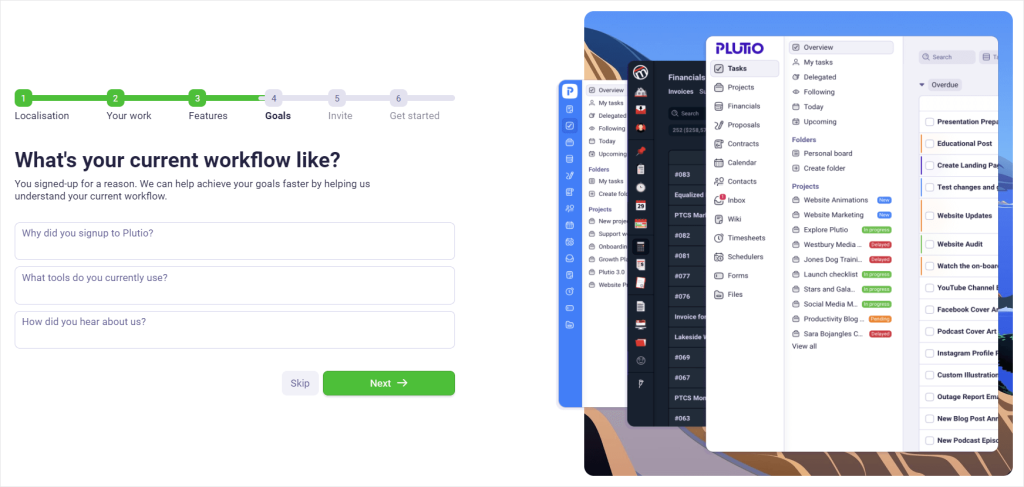
In Zendo, you get a demo content as well, but in entirely different shape and form. Instead of a to-do list, you get a series of thread conversations between well-known characters from pop culture, from S’chn T’gai Spock to Ellen Ripley and Agent Smith. This not only makes the whole experience much more entertaining and interesting, but you also get the chance to see the features in action.
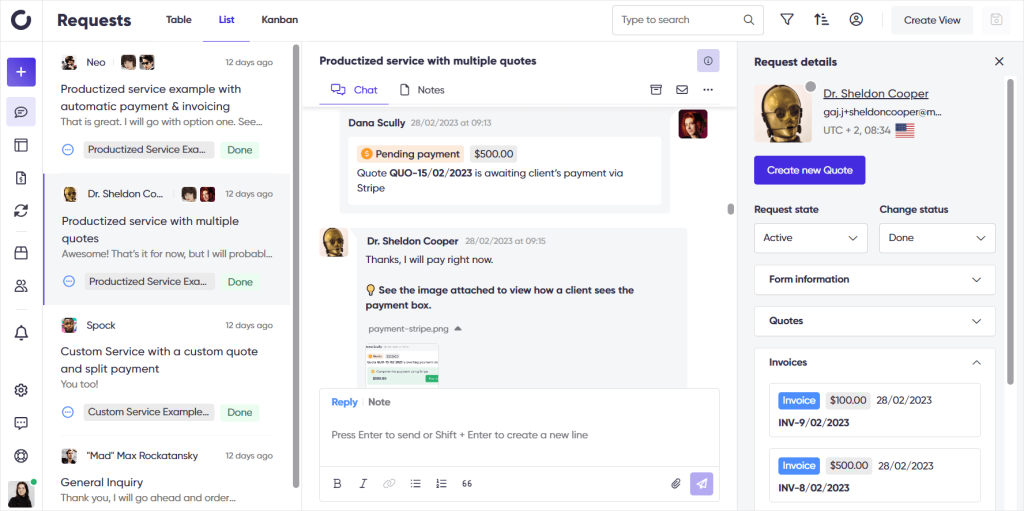
TLDR: Zendo is easier to set up and offers up-to-date demo content that helps you learn all of its functionalities. Plutio requires more time to get a handle of, and its guides are in need of an update.
General Workflow
Both tools offer a completely different experience when it comes to handling clients’ requests. Plutio has a very traditional and more common approach, which you might be already familiar with, especially if you used Scoro or other similar collaboration tools:
- A client gets in touch with you via email and describes their project,
- After discussing it, you create Proposals, Contracts, or Agreements in Plutio and send them to the client,
- Once it’s been signed, you create a Project, Task Group, and Tasks in the platform, then assign them to team members,
- Now you watch over the project delivery and stay in touch with the client through the platform’s chat,
- Once the project’s been delivered and accepted, you can issue an invoice and collect payment.
Meanwhile, Zendo proposes a completely different scenario, that’s more in tune with modern way of doing business, where you focus on results and concrete actions instead of micromanagement:
- You create a predefined Service, either a custom, productized, recurring, or a free one,
- Your client visits your Service Catalog, where all your Services are listed. After customizing their request, they can submit it. If they chose a recurring service, they’ll be asked to pay upfront,
- The request will land in Zendo, creating a new conversation thread in chat. Both the client and assigned teammates can interact with it,
- Depending on the type of service, you can send a quote and a payment request at the right time. This can also be automated in Service’s settings,
- Your client can pay for the service directly in chat, without the need to switch to another app or even a tab,
- At the end, you can issue an invoice in chat or have it sent automatically, depending on your settings.
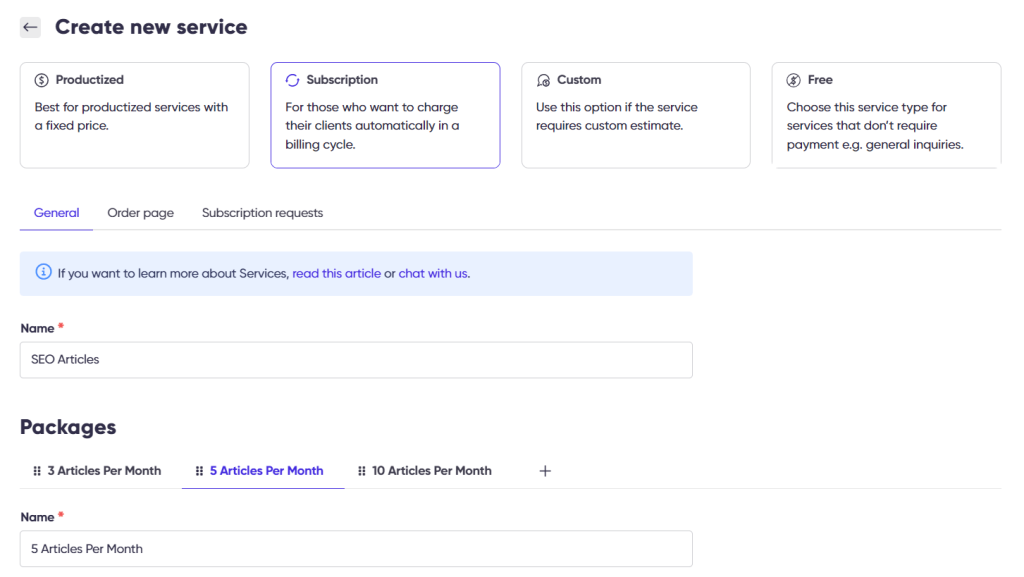
As you can see, everything of importance, from discussions and gathering data to sending documents and finalizing payments — happens in one place only. The chat is at the heart of the platform, giving you easy access to all the essential features to close any deals and deliver what was promised. This workflow is much more in tune with doing business than creating endless lists of tasks.
TLDR: Plutio comes with a typical workflow, where you discuss projects via email and send all documentation to client’s inbox, set up tasks on the platform, and accept payments through invoices. Zendo, on the other hand, requires clients to submit their requests through Service Catalog. Everything else — sending documents and finalizing payments — happens right in Zendo’s chat.
Project Management
In Plutio, project management is like an onion: it comes with many layers. Thankfully, none of them will make you cry.
First, there are Projects themselves. They have their own tab on the left, which gives you an overview of all current projects, their progress, assignees, budget, and clients. Above them all, you can see all the stages that each of your projects go through and how many projects are in which stage. This gives you a nice rundown on what’s currently happening in your entire business, giving you a sense of control.
Default stages are: New, In progress, Pending, Delayed, Completed, and Canceled. In Settings, they can be wholly customized to reflect your own unique processes.
Then, each Project can be further divided into the unlimited number of Task Boards. Task Board is a group of your tasks that can be viewed in the form of a list, table, Kanban, calendar, or a timeline. So for example, if you have a big enough project that includes work of different departments — marketing, design, and development — you can create a Task Board for each.
Next, you can create individual tasks and group them together. Each task can be assigned to a team member and have a set deadline. Moreover, you can describe the task in detail by attaching images, code, quotes, tables, and any other form of media.
While all that might sound interesting, it might lead to overmanagement, where instead of actually working on things that bring negligible profit, you start focusing on bells and whistles. It’s a common problem that Plutio doesn’t really solve.
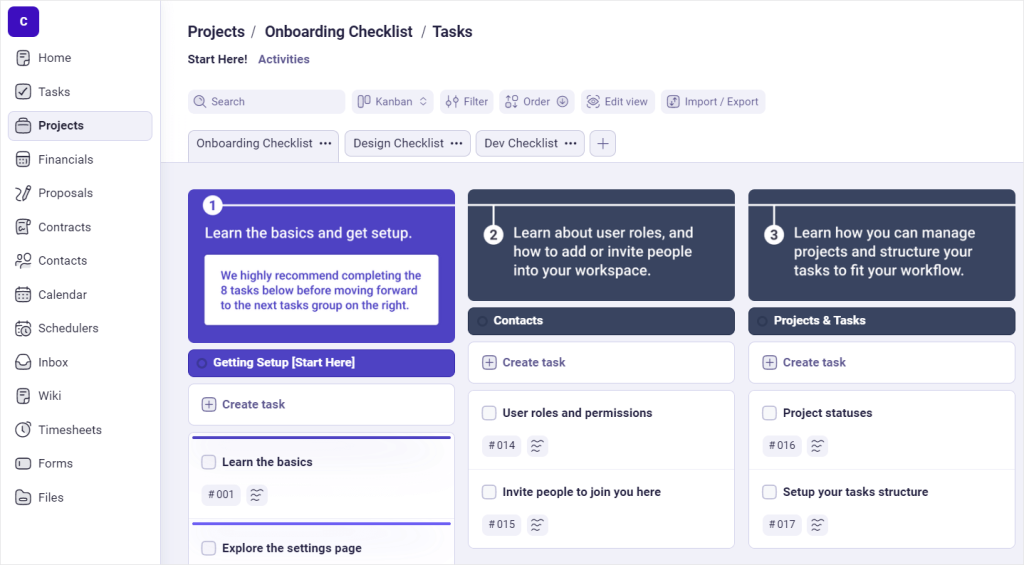
Zendo takes a completely different approach to project and task management.
You won’t find any projects or tasks in the platform — instead of acting as Asana with clusters of tasks and invoicing options, it only includes these functionalities that truly support selling services.
Each new order that comes through Zendo’s Service Catalog becomes a Request. Your main dashboard consists of chat and a list of all your Requests that can be found on the left sidebar. You can also view them in a Table or Kanban board, and filter them thanks to Statuses, which are fully customizable. So at a glance you can tell which Requests are, for example, “In Progress”, “Awaiting Payment”, “Done”, or “Canceled”.
Everything that you need to know about a Request can be found in the Request itself — there’s no need to keep switching between different tabs to gather relevant information. All the Quotes, Invoices, and attachments, from images to video and audio files, that were sent in chat will be automatically saved and displayed on the right panel for quick and easy access.
You can also use the right panel to:
- Manually change the Status of the Request — there’s no rigid pipeline, so you can keep jumping between different Statuses however and whenever you need,
- Assign agents or watchers to the Request or remove them,
- View and edit Custom Fields. You can create as many Custom Fields as you need and use them to store important information, for example: the priority level or competencies needed,
- View form information that was filled out by the client while submitting the Request,
- View general information on the Request (ID, creation data, type of service, etc).
Moreover, each Request is defined by a Workflow. After all, you’re probably going to offer many different services and each might need a different process to deliver it — some might be long and convoluted, while others pretty straightforward. To take into account those differences, each Service needs to have a default Workflow assigned. A Workflow includes the aforementioned Statuses, Custom Fields, and Triggers, that can help you automate the process. You can also decide what should be visible to clients and craft your follow-up message that will be sent automatically as the first message.
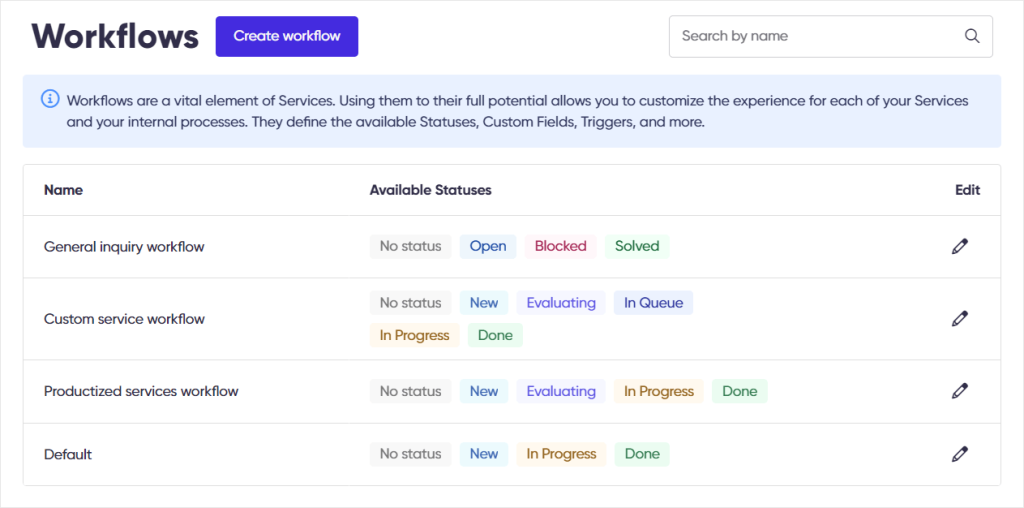
Still, we kept Workflows as flexible as possible. That’s why you can edit it even in the middle of the job, switch it for another, or make it completely unrecognizable. In Zendo, nothing is set in stone — while you do have a certain structure to follow, you can change the rules anytime you wish. Zendo should guide you, but never restrict you.
TLDR: Plutio offers a typical project management that’s similar to Trello or Asana, where you can create clusters of tasks with their own clusters. In Zendo, when your client submits a Request, it essentially creates a project in the form of chat where all important information is stored.
Roles & Permissions
Plutio has four different roles by default:
- Owner — the workspace’s creator that can invite co-owners,
- Co-owner — has the same permission levels as the owner and can invite co-owners,
- Client — only has access to things assigned or related to them,
- Contributor — custom role with custom permission levels; you can create as many custom roles as you need.
These roles represent very well Plutio’s approach to management — you get the basics and then you get the fully custom experience where you have to set everything up manually. There’s a catch, though: contributors are only available in the higher pricing tiers.
Meanwhile, Zendo put more thought into what kind of roles you might need:
- Owner — the workspace’s creator that has access to all settings, including Plans & Billing,
- Admin — this role can view and interact with all Requests as well as assign users to Requests and manage most of the settings,
- Manager — this role can view and interact with all Requests,
- Agent — a default role that can view and interact with Requests that were assigned to them,
- Watcher — a passive role that can only view Requests that were assigned to them.
Additionally, Zendo thought of the following scenario: what to do in the case of when one of your team members goes on holidays or a medical leave and they were the one responsible for handling a specific Request? Introducing: Impersonation.
Impersonation is a great feature that allows a user to take over somebody else’s account. Of course, it’s not a free-for-all kind of situation — different permission levels allow for impersonation of specific roles only. So for example, an agent can’t impersonate a manager; but a manager can impersonate an agent anytime.
Also, all users, with the exception of watchers, can impersonate clients. It’s a particularly useful feature in case of troubleshooting, someone forgetting their credentials, or to simply speed things up.
TLDR: In Plutio, you have the freedom to create completely custom roles with personalized permission levels. Zendo gives you five predefined roles that are tailored to the software and an impersonation feature.
Teamwork
Teams will find that both tools offer completely different experiences when it comes to working together.
Plutio has a more traditional approach. It’s within the team’s responsibility to enter all the relevant information to the system and keep updating their projects and tasks manually. You have to keep switching between different tabs and look all over the platform to see what’s new. If one of your team members comes back after a holiday, they might have trouble getting up to speed. And onboarding of new employees might be even trickier.
In Plutio, it’s necessary to appoint project managers just for tracking work progress and keep watch over everything that’s happening on the platform. The level of customization and complexity to each project requires a lot of attention to make sure there aren’t any mistakes or to prevent misunderstandings or redundant questions. You can even create custom dashboards for each user — but as you can guess, that’s a nice gimmick that doesn’t necessarily push the work forward, but puts more on your plate.
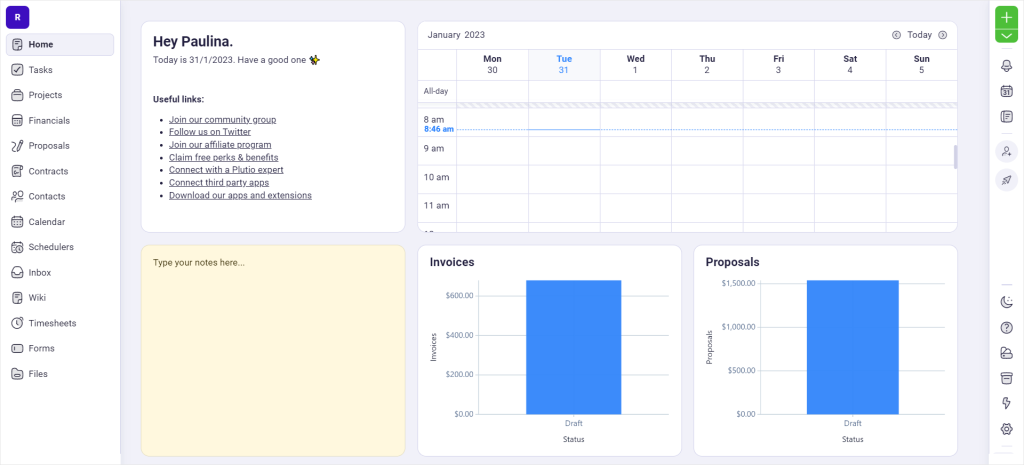
That’s not an issue with Zendo at all. It supports healthy and transparent communication by erasing all the unnecessary steps in handling clients’ requests and limits the number of tabs you need to keep checking. Instead, all the information you need is collected in each Request, with no need for any other documentation to be run somewhere else. Through there, you also have quick access to a Client Profile, where you can see the whole history of their business relationship with you. There’s a list of all their Requests & Subscriptions that you can jump to, all the attachments and documents ever exchanged, as well as notes that you and your team members can save for future reference.
Moreover, when you’re busy discussing the project with a client and stumble on an issue, you can send internal notes right in chat to other team members with the client being none the wiser. To make sure the other team member notices your question, you can even mention them by using the asperand (@) symbol.
Client’s Perspective
Your chosen project management tool shouldn’t only streamline your processes and make your life easier, but also ensure the best possible customer experience. So it must be easy-to-use for your clients, convenient, and impressive.
In Plutio, your clients start off by getting in touch with you via email. Most of the conversation will happen through this channel, which while popular, isn’t always that convenient. We all know from experience that exchanging back-and-forth emails isn’t always the most efficient way of closing deals — the reply time leaves much to be desired, it’s normal to keep forgetting to include relevant people in the conversation through BCCs and CCs, and you have to remember to manually transfer all the information mentioned to the platform.
But one thing that Plutio does well is that you can create Proposals, Forms, and Contracts, either from scratch or by using a template. Then, you can send them to the client via email. In case of Proposals, you can create Productized Packages to offer more variety and utilize the upselling techniques. And in case of Contracts, your clients can sign them with electronic signatures, which are legally binding. And you can use forms to gather necessary information to proceed with the order.
It’s also worth noting that all these documents are reusable. So although it might take a while to achieve the perfect look that reflects your brand, you’ll be able to quickly use them again with other clients.
Once everything has been agreed on and you start working on the project itself, you can invite your clients to their own space on Plutio. On their Client Portal, they can view all their projects and check on their status, see their documents, create and assign tasks to the team, and talk directly with you.
Zendo, on the other hand, tries to eliminate the email entirely from the equation (although everyone can still get notifications and clients can answer from their emails, without the need to login to the platform). First of all, the whole customer journey starts off with a Service Catalog.
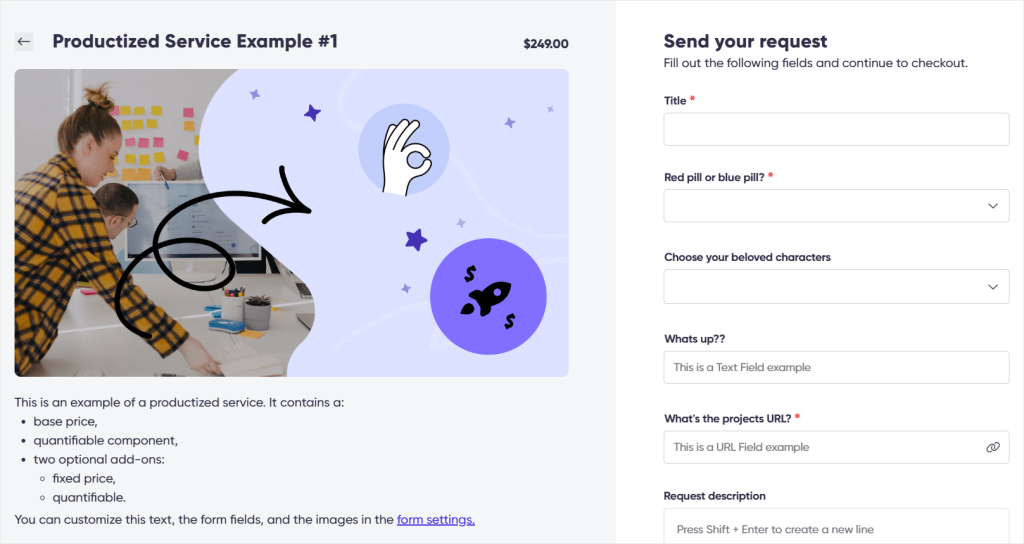
Service Catalog is the place where you can list all of your offers in a highly professional manner that’s easy on the eyes. Service Catalog comes with its own URL, so you can link to it on your website or anywhere you wish to. You can of course restrict access to it, allowing only registered Zendo users to submit a Request.
In the Service Catalog, your potential customers can take a look around, see what kind of services you offer — be it productized packages with add-ons, custom services that will be estimated later on, or subscription-based services — and customize the chosen one to suit their needs. Then, they’ll have to fill out the Order Form with necessary information that you have set up earlier, and submit their Request. Now, if they want to keep an eye on their Request and take further action, they can login to their own Client Portal.
The Client Portal itself looks just like a normal workspace, but with the option to access only their own account settings as well as view and interact with their Requests.
Clients can interact with the Request similarly to agents — they can send messages and attachments, accept and reject Quotes, view and download invoices, as well as finalize payments with a single click. They can also submit new Requests right there and discuss anything pertaining to their orders.
Having one single platform to do it all makes for an easy, quick, and convenient way of ordering and delivering services. Your clients can’t ask for a better experience, especially when you pair it up with the white label features and make Zendo seem like your own personal platform.
TLDR: In Plutio, client communication happens on two channels: good old email and Plutio’s Client Portal. Zendo has the Service Catalog and its own Client Portal, which makes it possible to avoid sending emails entirely.
Subscription Plans
Plutio offers three different plans: Solo ($19/month), Studio ($39/month), and Agency ($99/month). The Solo plan only allows you to invite up to 3 clients, so for those who want to kick start their business, this restriction is a deal breaker. Especially since you can’t invite any contributors, as the name suggests.
The Studio plan doesn’t have a restriction on the number of clients, but it limits contributors to 10. If you go above that limit, you’ll have to pay more, but all in all, this doesn’t stray far from what the market usually offers.
Last but not least, the Agency plan comes with 30 contributors and a white-label feature (although the white-label option can be bought as an add-on in the previous plans as well).
For a more in-depth analysis of these subscription plans, including the add-ons and the exact value you get for that money, read our article on Plutio’s pricing.
Zendo offers three subscription plans as well, but they’re much simpler.
First, we have the Starter plan. It gives you access to most of the features with the exception of white-label and automaton. You can invite as many clients as you want, but there’s a restriction of 2 users in this plan. Considering the fact that it’s an entirely free plan, it’s a great option regardless to test Zendo out. You’re also given 5 tokens to test out the premium features as well, to experience everything the platform has to offer. Because of that, you won’t find a free trial offered anywhere on Zendo.
Next, we have the Growth plan, which costs $19 per seat, per month. This plan gives you access to all the features, with the only limit being 100 agents.
And if you’re in need of some more tailoring and unique features, as well as unlimited users, you can invest in the Enterprise plan. Depending on your exact needs, this pan requires custom estimation, so it’s necessary to hit up Zendo’s team for more details.
All in all, this makes Zendo a highly attractive and affordable option for both freelancers and agencies, no matter their size and experience.
TLDR: Plutio offers three subscription plans, but you should only consider Studio, which offers the best price to value ratio. Zendo has three plans as well, but one is entirely for free, making it a real catch.
Zendo: Best Plutio Alternative?
If you’re done with Plutio and its fixation on customizing every single detail that doesn’t push us closer to selling services successfully, Zendo could be your new business partner that you’re looking for. Unlike any other popular project management tool, it takes a unique approach to managing projects, truly making your work faster and more efficient, instead of drowning you in tasks and their subtasks. This project management software offers the most simple solutions to complex problems, helping you save time for real.
And if you’d like to talk with the Zendo team personally, join our Discord server, where we can discuss your options and get to know each other better!

A free online training. Delivered daily to your inbox to grow your productized agency.
What Is Plutio?
Plutio is an all-in-one project management tool that helps freelancers and small businesses handle their daily work more switfly and efficiently. With it, you can elevate your project and task management capabilities as well as craft beautiful templates for contracts, proposals, and forms to impress your clients.
What Are Cons To Plutio?
Plutio allows you to customize just about everything on the platform, from color palettes and templates to dashboards of each user. While it sounds nice in theory, in practice it might lead to getting stuck repeatedly on the details. Instead of focusing on the work that brings actual profit, you might keep losing time on perfecting the little things that don’t matter in the end. Another con to Plutio is its outdated guides and knowledge base, which makes it harder to learn how to use the platform.
What’s The Best Plutio Alternative?
The best Plutio alternative available on the market is Zendo, a software tool designed for selling productized, subscription-based, and custom services with ease. It comes with a convenient Client Portal that allows your clients to order your services quickly and with no fuss. Moreover, it’s a very affordable software that comes with a free forever plan for up to 2 users, so it’s a perfect choice for those just starting out.
How Can Zendo Help Me?
Zendo offers simple solution to complex problems. Instead of drowning you in tasks and subtasks, it streamlines the process of selling services by eliminating all the unecessary steps of your business — it substitutes your email inbox, allows you to send quotes and invoices directly in the app, takes the paperwork off of your hands, and helps you showcase your tempting offer in a Service Catalog, which effortlessly leads your clients throughout the whole customer journey.











